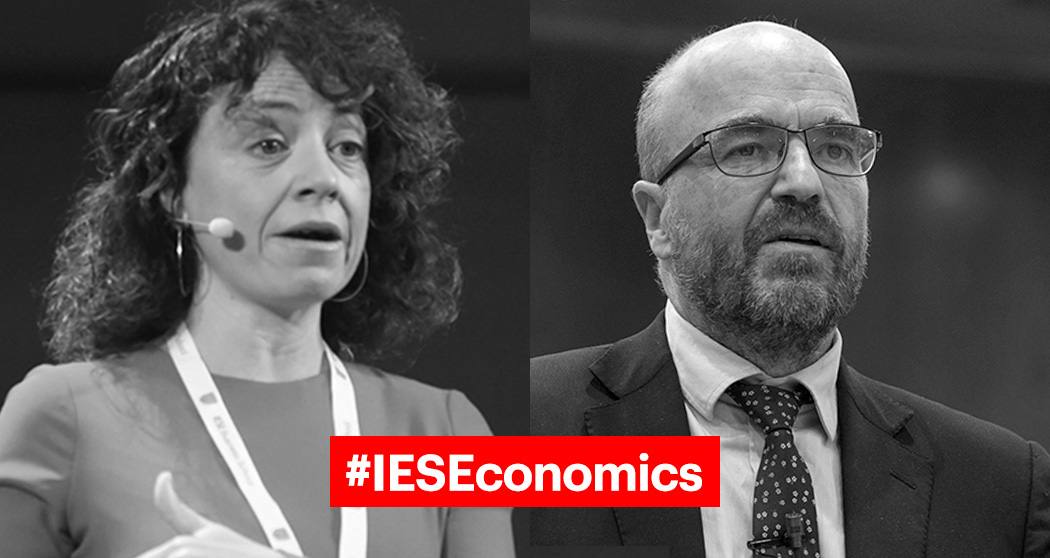
IESE Insight
What will the war in Ukraine mean for the economy?
Economists Nuria Mas and Javier Diaz Gimenez discuss the latest global growth forecasts, the specter of inflation, policy responses, vulnerabilities and more.
In addition to a critical humanitarian crisis, Russia's ongoing invasion of Ukraine has delivered a wallop of an economic shock, one with many repercussions now and going forward. From IESE's Economics Department, Nuria Mas and Javier Diaz Gimenez offered their analyses of the war's fallout.
"Permanent" inflation settling in
Food and energy prices are important components of inflation. For Europe, Russia and Ukraine are key suppliers. That prices are climbing is clear. "The question used to be: Is the inflation we are experiencing now transitory or permanent?" said Javier Diaz Gimenez. "Well, now we know." It will be more "permanent," meaning it will have a lasting impact. Nuria Mas agreed that the war changed the economic outlook completely. Instead of inflation that was supposed to temporary -- and coupled with impressive growth -- we have a different scenario to handle, but she also highlighted the possibility of stagflation ending up being deflationary in the medium term.
As inflation takes hold, "we will be poorer," Diaz Gimenez warned. Businesses should plan for this possibility.
A supply shock is hard to fix
"In economics, to put it simply, we tend to think about two types of shocks: demand
and supply shocks," Mas explained. Of the two, demand shocks are easier to handle with the policy tools on hand, because governments can spend more to stimulate demand. What's happening now, however, is clearly a supply shock, because high commodities prices are hitting producers very severely. In this situation, there is likely to be less growth but higher prices. So, what should policymakers do? To stimulate the economy, governments may not want to risk pushing up prices even higher.
To look at the current shock, Mas recommends a closer view of four transmission channels: commodities prices, international trade, the supply chain and confidence. Looking at these four channels for the United States, Germany, France, Italy and Spain, "all have clearly been negatively impacted," she said. And Germany and Italy have the highest exposure. The supply shock is clear. How long it might last is another question.
Four scenarios
While we don't know what is going to happen next, coming up with possible scenarios helps with business planning. Here are four possibilities:
1. A long and drawn-out war would have a lasting impact on food and energy prices, which means inflation rates may remain high. This is the scenario that looks most likely, with Ukraine's fierce resistance to occupation.
2. A diplomatic agreement is the best-case scenario, with a limited impact on the economy. But would peace come in time to plant crops and ease other pressures on prices? Spring is here and it's time to plant.
3. An escalation, with NATO entering, is a frightening possibility. But we have to think about it to be prepared, both professors said.
4. A de-escalation, with sanctions and the human costs of war weakening Putin over time, is likely to be faster than option 1, but still slower than option 2. Russia's GDP is expected to fall by as much as 11% this year. Yet Putin seems determined to stay the course.
Energy dependence
In any case, "we have learned that Europe is vulnerable with its energy dependence," said Diaz Gimenez. "Europe needs to become energy self-reliant." With Russian gas accounting for 40% of Europe's gas imports, that point become
s clear. Drilling into the details, it's not easy to find substitutes, Mas explained. "Maybe the UK and Norway could provide a bit more," but not enough, she said.
As with the COVID crisis, Europe's response so far is unified and promising. The financial sanctions on Russia are a clear case of this. Now seems to be the time to finally put forward a unified energy plan. Already, the European Commission has proposed an outline of a plan to reduce 60% of Europe's dependence on Russian gas by December 2022, boosting renewables at the same time.
Global GDP outlook: more volatility ahead
"2022 was supposed to be an amazing year," explained Mas. When the COVID crisis was waning last year, the International Monetary Fund (IMF) predicted robust global growth of 4.9% for the year ahead. In January 2022, with the Omicron wave, the IMF's 2022 estimate was reduced to 4.4% growth. And coming very soon, in mid-April, we'll hear the IMF's latest forecast. "Everybody is now guessing less than 4.4%," said Javier Diaz Gimenez. "The big mystery is how much less? Will it be 3.9%, 3.4%, 3%?"
In sum, "while the world is still recovering from a pandemic, Russia's invasion of Ukraine is a brutal shock which impacts the entire global economy," in Diaz Gimenez's view. "The Bank of England and the U.S. Federal Reserve have already raised their rates and, of course, that impacts the entire global economy," he said. "The volatility and uncertainty will be massive," agreed Mas.
The full session of "War in Ukraine: economic fallout" includes more information on policy responses, geopolitics and the impact on emerging economies.
Forward to 6:17 to begin session.
